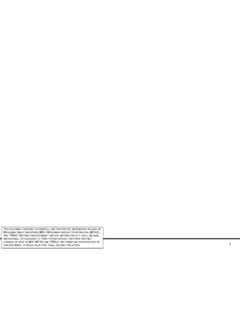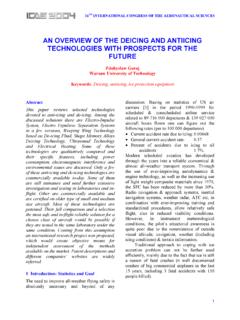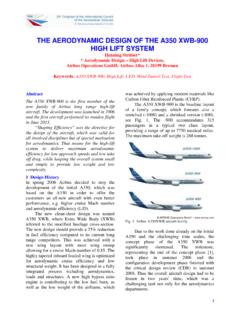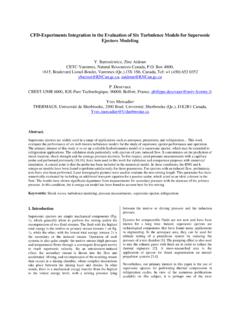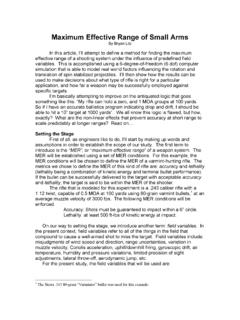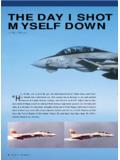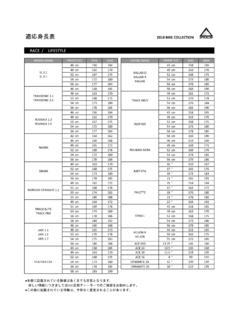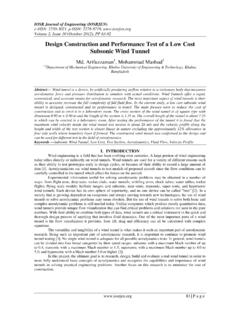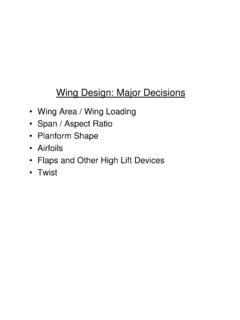Transcription of ULTRA LIGHT WING STRUCTURE FOR HIGH …
1 ICAS 2000 paper presents a conceptual design ofmain wing, body and empennage for highaltitude long endurance unmanned aerialvehicle. An arrangement of main spar, ribs,shell and strut for high aspect ratio main wingand tailplane has been proposed. A number ofcharacteristics (stiffnesses, mass distributions,moments of inertia etc), necessary for fluttercalculations, is included in this paper. Thestructural characteristics are computed usingNASTRAN programme. The critical flutterspeed for empennage has been found by meansof the conventional U-G method. The Doublet-Point-Method (DPM) for non-coplanarconfiguration was used to compute the unsteadyaerodynamic forces.
2 Aerodynamic model ofempennage includes 168 aerodynamic analysis can be treated as a starting pointfor further wing optimisation. The main goal isto obtain the STRUCTURE lighter andaerodynamically more efficient - the feature -being very important in long IntroductionStratospheric flights can provide wide, newopportunities for commercial, scientific andmilitary activity. Among typical tasks there are:reconnaissance, border patrol, illegal air trafficcontrol, source of pollution emissions andtransport of pollutants observation, crop andforest assessment, flood and fire control,monitoring and wildlife migration, volcaniceruptions and ocean currents, observation ofhighway traffic-patterns and congestion, cloudsand their influence on climate processes,exchange processes between biosphere andatmosphere, observation of land/ocean/polaricecaps and many others.
3 Successful buildingof the High Altitude Long Endurance (HALE) Configurations initially consideredUAV aircraft is conditioned by overcoming afew serious obstacles. Among these obstaclesthere are very special aerodynamics (lowReynolds Number coupled with locallytransonic speeds), propulsion technology (incivil application the turbocharged piston engineof low operating cost is preferable), controlsystem (possessing the best features ofpreprogrammed and hand-flown modes) andvery LIGHT structures of wing and fuselage. Thispaper focuses mainly just on aircraft STRUCTURE , ULTRA LIGHT WING STRUCTURE FOR HIGHALTITUDE LONG ENDURANCE UAVZ dobyslaw Goraj, Warsaw University of Technology, Warsaw, Ueda, National Aeronautical Laboratory, Tokyo, Japan airplane design, , very LIGHT and intended to be should be inexpensive in initialand operating costs.
4 The basic option is payloadweight of 300 kg. Depending on expectedmission the payload weight is flexible in therange from 100 to 1000 kg. The maximumaltitude is 26 km and corresponding enduranceis 48 hours. However this endurance can beelongated for lower altitude [ 1]. The basic ideafor such aircraft has been created in 1995 [2],when a conceptual project has been developedand submitted for DARPA, Fig1. This paperpresents some major milestones in the projectdevelopment, made jointly by WarsawUniversity of Technology and NationalAerospace Laboratory and is devoted mainly tothe main wing design and preliminary power at departure altitudecould be obtained only by the use of multistageturbocharger with a liquid intercooler.
5 Thecompound propulsion system concept,developed by GROB Luft und Raumfahrt forSTRATO 2C, has been adopted, as a basicsolution with a modification presented in [1].The power requirement of the aircraft - aproduct of drag and airspeed - increases rapidlywith altitude. A suitable regulated turbochargerof the modified, compound propulsion systemcan maintain its available power of 400 kW at aconstant value right up to the design of the compound propulsion system aregiven in [1,3,4]. The construction of the aircraftis based on glass fibre / carbon fibre design,including the fuselage, the container withmeasuring apparatus and a Main wing structureThe wing consists of an upper and lower shellof sandwith construction, a number of ribs, themain spar, a nonbearing front wall, a torque boxand a number of chordwise stiffening strips, These prefabricated fibre compositecomponents are joined using the same syntheticresin as a bonding agent.
6 The chordwisestiffening strip section is shown in Itsexternal envelope consists of the two interglassfabric, of 92110 symbol. The unit weight of thisfabric is 140 g/m2. The internal filling weights60 kg/m3. The wing is supported on a double-rod angle struts, increasing both bending andtorsional wing stiffness, ,5. Wing area is60 m2 , its span is 34 m and aspect ratio is [5]. The general arrangement of the main spar,the rear wall torque box, main ribs and theangle strut support point are shown in details, including aileron, angle strut andvarious dimensions, are shown in Theshell of sandwith construction is also shownhere. It consists of one outer layer fabric(91110), two inner layer fabric (92125) andfilling of 8 mm thick.
7 Attachment of the mainwing to the fuselage is shown in Themain spar of the wing (shown in ,4,5,6,7,8)has two strips of constant strength. Itsdimensional mass (the mass of the current unitlength per the mass of unit length in the area ofangle strut attachment) is given in Forgeneral flutter prevention of the airplane thefollowing design characteristics and solution areusually used [6]: torsional stiff wing LIGHT control surfaces stiff control system a partial mass balance of the primary controlsurfaces a stiff servo tab linkage (or rods) withminimum backlash very LIGHT aileron, made of carbon fibre( ).3 Stiffness, mass, moments of inertia andother distributions for wing, tailplane andfuselageThe main wing, tailplane and fuselage and theirdimensions are shown in Alldistributions needed for aeroelastic analysiswere calculated coming from wing STRUCTURE ( ,7) and characteristics of appliedmaterials.
8 Basing on the glider designexperience, gained in the Warsaw University ofTechnology, some of the obtained results werecompared to the corresponding characteristicsof composite wings of similar LIGHT WING STRUCTURE FOR HIGH ALTITUDE LONG ENDURANCE , because these numerical results werenot validated by testing a representativestructure, so they have to be treated asapproximated values with a prescribed degreeof uncertainties. ,13 give bending andtorsional stiffness for main wing, versusspanwise station. ,15,16 present: (1)centre gravity location; (2) polar moment ofinertia per unit length and (3) mass distributionper unit length, respectively. relate totailplane wing and give: (1) bending stiffeness;(2) torsional stiffness; (3) relative centre gravitylocation; (4) polar moment of inertia per unitlength and (5) mass distribution per unit length ,respectively.
9 Fuselage has circular cross sectionand its stiffness and mass characteristics areshown in All characteristics given correspond to empty STRUCTURE (excluding fuel, power unit, control systemsetc).4 Aeroelastic analysisAs a starting point an empirical method(developed by and , [7])was used to evaluate flutter vulnerabilitywithout extensive computational analysis and totake appropriate preventive derived design frequenciesrestricted the number of vibration modes whichhad to be considered. Simple formulae wereused for the calculation of the torsion frequencyand the critical torsional flutter speed. The firstapproximation STRUCTURE designed on this basiswas further analysed in details by means ofmore refined approaches using FEM ANSYSand NASTRAN coupled with external loadsgiven by unsteady aerodynamics.
10 The point-doublet lattice method (developed by , [8]) was used to estimate theaerodynamic pressure distribution along wingchord and wing span and then to calculate thebending and torsion modes of vibrations and thecorresponding frequencies. A number of designvariants has been checked out and optimised. Insome area of the flight envelope the basic non-augmented configuration was expected to bevulnerable to was selected as a startingpoint for preliminary consideration of the main wing is braced with struts whichadd the stiffness for bending and torsion, itseems to have rather high flutter , this should be checked , the empennage has uncommonlyhigh aspect ratio and negative dihedral angle.
